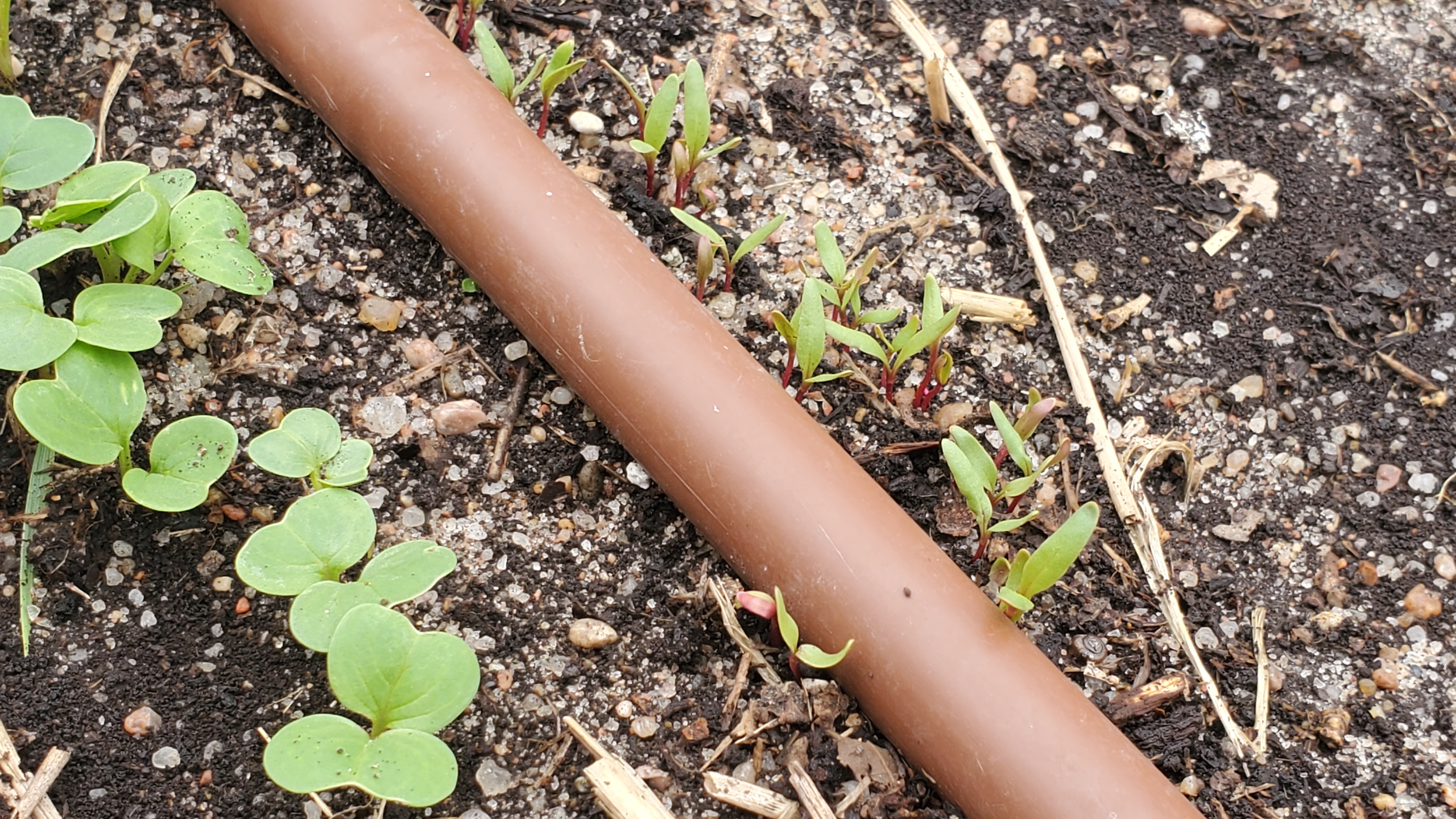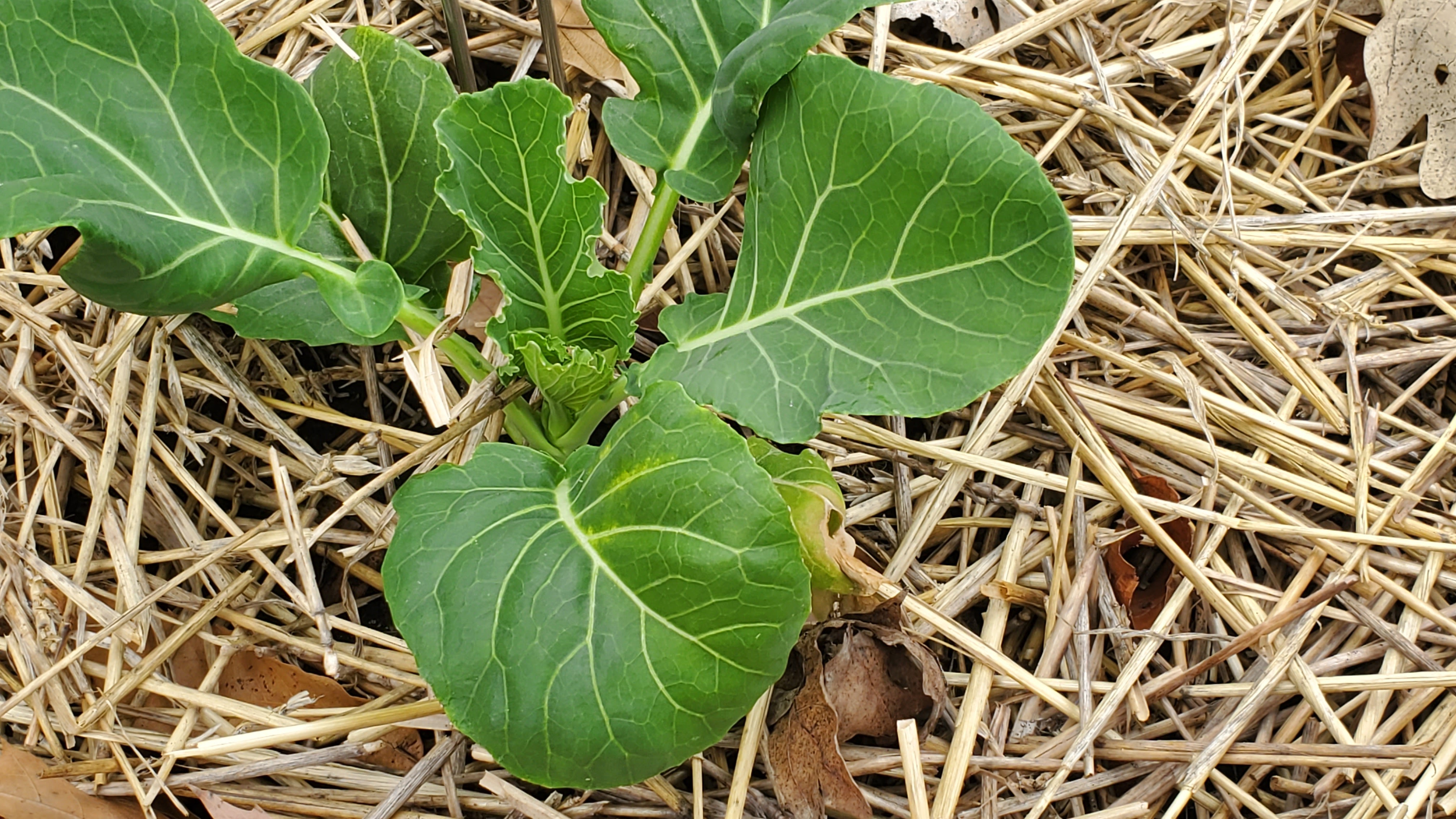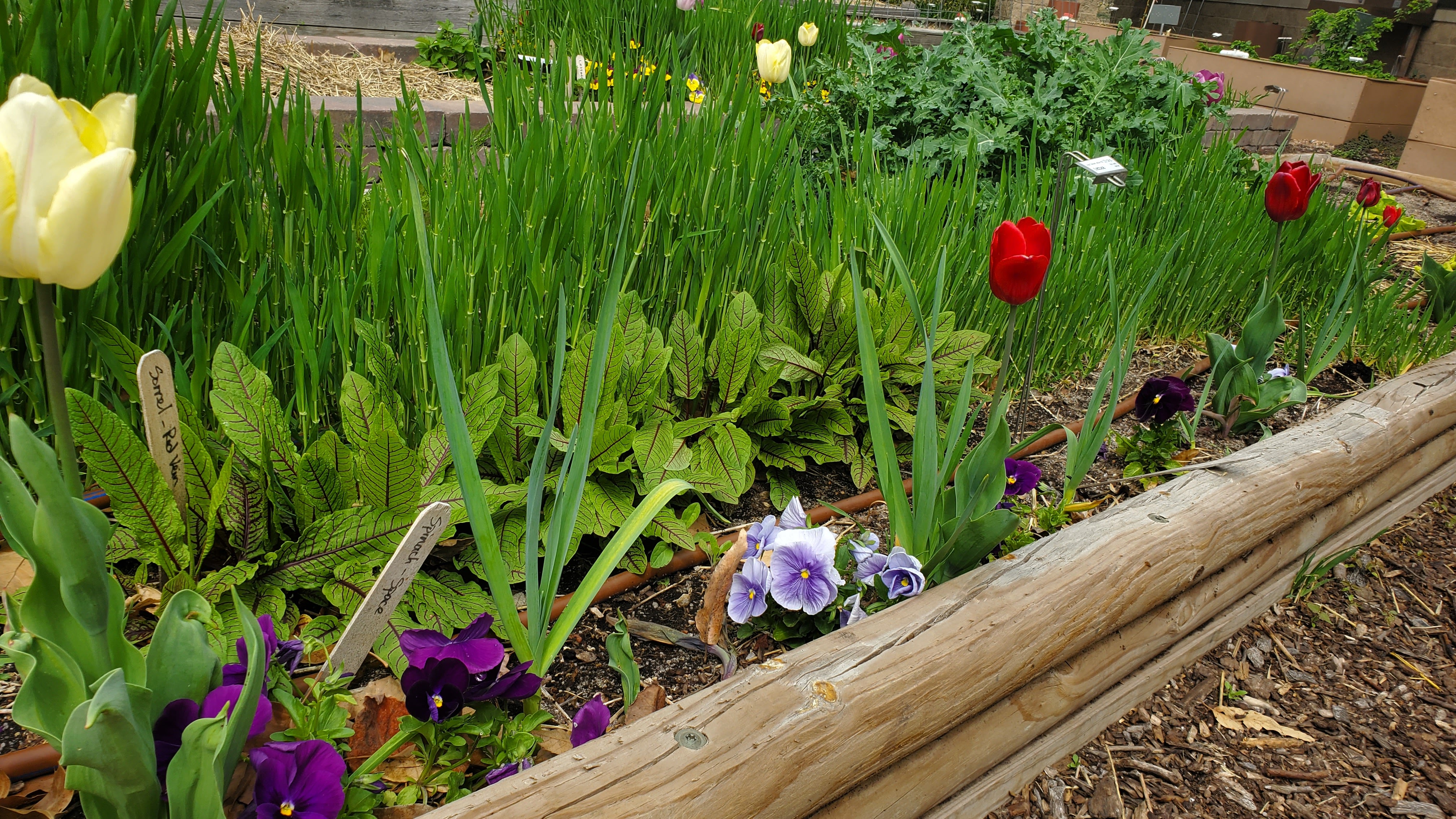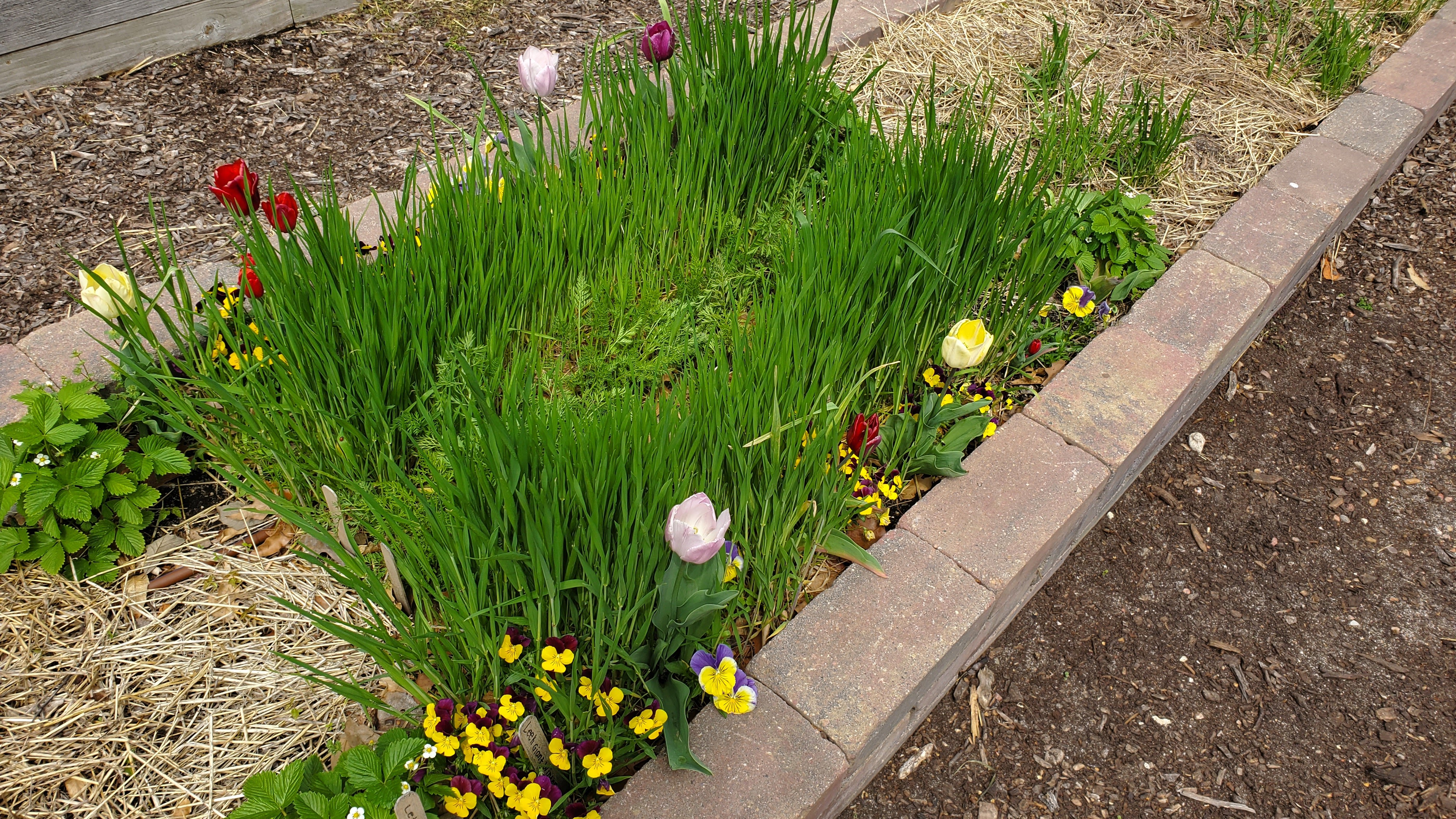A Closer Look: Bed 2 Plans
Today let’s take a closer look at the plans for our second bed in the Demo Garden. This bed is fairly simple, compared to Bed 1. Half the bed is planted to tomatoes (and basil!), while the other half will be planted to potatoes in the spring and leafy greens in the fall.

I know that you are probably really excited to know more about the tomatoes – but in the interest of having something to talk about when we get to Bed 5…I’m going to make you wait. Sorry!
So that leaves us with the potatoes and the leafy greens. Bed 2 is our only raised bed that did NOT show nematode damage last season, so it is both our “control” bed for our tomato varieties so we can compare productivity and growth with Bed 5, which has heavier nematode infestation. We also chose to plant potatoes in this bed, since they can have nematode issues as well. One of our Master Gardener plants red, white, and blue potatoes with their grandchildren, so we thought that would be a fun approach.
In the half of the bed with potatoes, we divided the space into three 4’x4′ areas, with each area for a different variety. Our red variety is ‘AmaRosa’ Fingerling. I know the map has three things listed – we weren’t sure what we would be able to find, so I had a list to look for. But I found this one, which was our first choice. ‘AmaRosa’ is a fingerling potato (so longer and slender), with red or burgundy skin and marbled pink and white flesh. Yep, interior flesh is pink and white! We actually just planted the potatoes this morning, and I was pleasantly surprised by how large the seed potatoes were, so that bodes well for a healthy crop.
Our white variety is ‘Kennebec,’ which is a long-time, high yielding basic white potato. It is a midseason variety, and has a good package of disease resistance. This is a common variety that you can probably easily find in a local garden center.
Our blue variety is a newer variety (although it has been around for several years at this point), called ‘Adirondack Blue.’ It is one of the darker blue/purple fleshed potatoes that you can find, and the color holds well, especially if you roast it. The plants themselves are also supposed to have a slight blue color to the leaves.
Once the potatoes are harvested in the summer, we will likely plant a buckwheat or sunn hemp cover crop in that area while waiting for cool weather to return for our fall planting. If you aren’t familiar with sunn hemp, it is a summer annual legume that grows quickly, fixes nitrogen, and suppresses root knot nematodes.
For our leafy greens, ‘Astro’ Arugula is probably the most common, reliable variety. ‘Black Magic’ is a newer cultivar of the traditional Lacinato/dinosaur kale that was selected for uniform, long, slender leaves. ‘Joi Choi’ Bok Choy is a larger choy variety, 12-15″ tall at maturity, with thick bright white stems. ‘Kookaburra’ spinach is a fast-growing semi-savoy variety that is supposed to perform well in the fall. It is fairly upright, which is nice in our gardens because the sandy soil can get on the lower leaves when it is rainy.
Check back next week to hear about Bed 3!
A Closer Look: Bed 1 Plans
I am cautiously optimistic that I will be able to go through each bed we have planned and go into more details about the varieties we have chosen and what we will be doing with each raised bed. So let’s kick that off with a closer look at Bed 1!

As we discussed in the general garden plan post, this bed is all about herbs (and some edible flowers)! Very generically, we could say that the green end is culinary, the red end is tea, and the blue is some of each. However, there are obviously some things that can cross over from culinary to tea and back. I’m not going to cover every last detail of each plant, because that would make this post ridiculously long. However, I do want to call out a few specific things.
First, the nematode situation. This bed had root vegetables in it last year, with variable levels of nematodes. The two central square tiers had parsnips all year long, and the parsnips were DISGUSTING on an epic level with their nematode infestations.

As you can see – disgusting – and not very edible. The longer end sections had evidence of nematodes, but weren’t nearly this bad, particularly on the radishes. We spend a long time looking for research papers and articles discussing nematode resistance in herb plants. One thing we found that was interesting was that some herbs – like mint and basil – had just as much root damage from the nematodes, but it didn’t impact their top growth. We found mixed results on things like marigolds, nasturtiums, oregano, marjoram, and salad burnet. So we are going to try all of those directly planted in the soil. The mint will be in pots because, mint.
The lemongrass and the Hibiscus sabdariffa (aka Roselle) will also be grown in very large pots. We will be procuring lemongrass stalks from a grocery store and rooting them to get the best culinary type. And the Roselle is the type of hibiscus that is commonly used for teas.
In the center of each end of this bed we will have some type of trellis, one with a jasmine plant and the other with blue butterfly pea (Clitoria ternatea). These are both vining plants with flowers used for teas.
Another plant of interest is the ‘Zloty Lan’ Chamomile – a variety that is supposed to have larger flowers and more robust plants.
Most everything else listed should be fairly straightforward, and we won’t know specific varieties until we are able to purchase the plants from one of our local vendors. I think it is safe to say that we should have a very fragrant and tasty garden in Bed 1 this year!
2022 Demo Garden Plans
Our garden plans for this year are both a return to a greater diversity of plants and the start of a multi-year effort to combat the increasing levels of root knot nematode that we have been experiencing in our beds. With the exception of Bed 2, all of the plants we removed or harvest last fall had some amount of root knot nematode damage, so we will be doing a wide range of things to work to improve that. (For more information on what root knot nematodes are, go here: https://hnr.k-state.edu/extension/info-center/common-pest-problems/common-pest-problem-new/Nematodes.pdf)

As you can see from the list on the right, we have quite a range of different things planned for the garden, including some things we haven’t done in many years and others that are brand new to us! We haven’t had a large area dedicated to culinary and tea herbs for many years. the herbs have mostly been in containers and smaller beds since we renovated the garden in 2012, so having the entirety of Bed 1 dedicated to herbs is a change for us.
You will also notice that we have “N-Resistant tomatoes” in both Beds 2 and 5. This means that we have chosen nematode resistant cultivars for our planting plans, with the exception of one variety that is our “control” variety as a comparison. In Bed 6, we have plans for a lettuce quilt (more below), and will be doing some soil solarization and cover crops after the spring harvest is complete in hopes of significantly reducing the nematode populations in that bed.

We have gone all out in filling our herb bed with a plethora of diversity! Very roughly, the green end are more culinary herbs (with some crossovers) and the red end is more tea herbs (again with some crossovers/dual purpose plants). The blue center is pretty much a mixture. Because the blue center sections of the bed had really terrible nematodes last year, we will be planting the majority of the plants will be in large containers, except for the marigolds, oregano, marjoram, salad burnet, and nasturtiums which are “supposed” to have some resistance to the nematodes.

Bed 2 was the only bed that didn’t have nematodes visible on the plant roots when we cleaned up the garden last fall. Whether that was because of the hot peppers populating most of the bed or other factors, it is hard to say. But with that in mind, we are using half of the bed as our “control” for our nematode resistant tomato cultivars. We chose 5 cultivars that are known to have resistance to nematodes, and one variety, ‘Chef’s Choice Orange,’ that is not identified as having nematode resistance, but that we have grown successfully here in the past. We will have the same cultivars planted in Bed 5, which had very high levels of nematodes last year so that we can compare the performance of the varieties in each bed. In the other half of the bed we will have red, white, and blue potato varieties in the spring and some cool season leafy greens in the fall.

In Bed 3, we have chosen a “Latin America” theme. We have jalapeno, Guajillo, anaheim, and chile de arbol peppers, all common in Latin America. We will have three different varieties of tomatillos: one green, one purple, and one sweet yellow. Tomatillos produce best when there are at least two different varieties for pollination. We chose two paste tomatoes (nematode resistant!) for this garden, as well as two Mexican/Latin American herbs: epazote and papalo. On the left end of the bed, we will have a round Mexican squash that is supposed to be resistant to squash vine borer, as well as Chayote squash. We aren’t sure that the Chayote will produce this far north, but you have to try things, right? Under the trellis we will be growing a whole bunch of cilantro in the spring and then let it flower and go to seed for coriander in the summer.
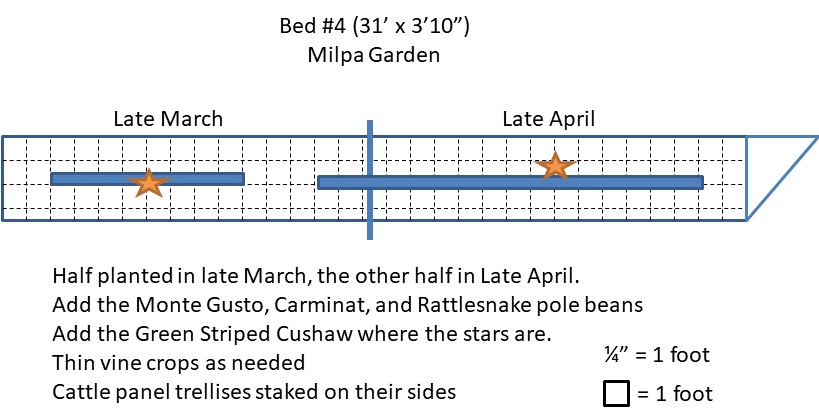
In yet another big change from past tradition, we are going to be planting the Milpa Cover Crop mix from Green Cover Seed as a partnership with our Sedgwick County Soil Conservation District. Not content to leave it alone, we are going to try it at two different planting times, and then add some additional pole beans and a green striped cushaw squash in the center of each half, with some of our trellises providing additional support. The mix isn’t really at its best in a raised bed situation, so we are going to have to judiciously thin out plants as we go to make sure that it isn’t a complete mess of things that will get into the walkways and such. That is also why we are adding in the trellises – just to give the vines a bit more room to roam vertically.

Bed 5 is the other half of our nematode resistant tomato variety demonstration, so the same things as in Bed 2. As you may have noticed, we are also trying out lots of the Emerald Towers and Thai Towers basils – new cultivars that are highly resistant to downy mildew and that are also much later to bolt (flower and seed) than other basils. We really want to see how they perform here!

Bed 6 is a little bit of a throwback to something we did several years ago – a quilt block lettuce garden. We are doing a basic nine-patch pattern with lettuce transplants on one end, plain rows of some root vegetables in the middle, and then a direct-seeded star pattern of lettuce and Brassica leafy greens on the other end. Once the spring crops are harvested, this bed will be covered with plastic for soil solarization, as this is our worst bed for nematodes. After several weeks of solarization, we will end the year with a cover crop that is also nematode-resistant/non-host.

In our accessible garden areas, in the tiered raised bed we will be reprising some cucumbers and melons that we attempted in 2020 but that didn’t quite get a fair trial with full attention.

Finally, in our salad table, we will have some mustard greens, radishes, and lettuce planted for the spring. The small barrel planter will continue to house our chives for another season. Not pictured is our new-last-year Tower Garden, which will have a mixture of leafy greens, herbs, flowers, vegetables, etc. I went through my old seeds to find some goodies, and with 53 planting holes to fill, we should have lots of options!
If all goes well, you should check back soon for more updates and details – although it didn’t happen last year. If nothing else, be sure to come out and visit the garden in person!
2021 Demo Garden Plans and Updates
Our Demo Garden plantings are well underway for this year, and we already have some exciting things to showcase. But first – here’s a quick overview of what we are planning to grow this year!

We chose to continue to focus our garden efforts on productivity and yield over diversity for this year. We are planning to continue donating our harvests to the Common Ground Producers & Growers Mobile Market for their Seniors First food box program, which provides free food boxes to low income seniors.
With that in mind, we are keeping each garden bed to only a couple different types of produce, although we still have more diversity of varieties than you might otherwise see. We are also focusing on interplanting and succession planting to use our space well. For example, in bed 1, we have radishes planted between rows of beets and carrots and IN the row with the parsnips to use every square inch of space. In Bed 2, we are filling the space with lettuce and spinach now, and then the peppers for the remainder of the season will be planted into the leafy greens while they finish their spring season. In Beds 4 and 5, we have planted broccoli, cauliflower, and peas under the trellises that will hold the cucumbers and squash later in the summer to get an additional crop out of those spaces.
The Master Gardeners have been hard at work getting the garden into shape for the spring, and almost all the beds have either seeds or transplants already growing. We had covered most of the beds with straw last fall, so that is both good and bad now – the soil stays moist with the straw, but we have lots of wheat seedlings growing. We also needed to move quite a bit of the straw around to facilitate seed planting.
The other thing I’m excited to show off a little bit are a couple of the school garden templates that I developed last year and planted last fall.
The templates are 4×8 layouts designed with high diversity (and relatively low productivity) for better interest and learning experiences in a school garden setting. (You can see all the templates and supporting information here: Kansas School Garden Guide.) Both of the templates shown here were designed to be planted last fall and overwintered. These overwintered with NO additional protection from the elements. They include pansies, tulips, garlic, shallots, alpine strawberries, barley or wheat, and vegetables (kale, carrots, red-veined sorrel, spinach).
If you haven’t been out in awhile, our garden is always open to the public – best viewed during daylight hours! Things will be changing fast as it gets warmer, so don’t miss out on the opportunity to visit.
What we’re harvesting

“The fruit derived from labor is the sweetest of pleasures.”
This quote from Luc de Clapiers perfectly sums up harvest in the Demo Garden! Our wonderful team of Extension Master Gardener volunteers has figured out how to navigate the difficult circumstances due to COVID and still have a very beautiful, productive garden. The fruits of our labor are gratifying to see and it is rewarding to pass on the fresh produce to those in need – more on this later!
So, what’s being harvested right now? Cucumbers, eggplant, tomatoes, peppers galore and more! This past week in the garden, I picked a small sample to bring home and taste test.

The peppers in the garden are starting to produce exceedingly well. There are many varieties being grown in the Demo Garden, but I tried just four. Since I’m not personally a hot pepper fan, I left those varieties alone and focused on some of the sweet pepper varieties: ‘Cornito Giallo,’ ‘Ajvarski,’ ‘Mad Hatter,’ and ‘Eros.’


‘Cornito Gaillo’ is a 5” yellow orange pepper that is outstanding raw, but roasting especially brings out the sweetness of this pepper. ‘Eros,’ a mini bell pepper, was remarkably tasty. The 2” orange fruit was distinctly sweet when roasted, and had an enjoyable taste uncooked. ‘Ajvarski’ is a sweet red 5” pepper. While this traditional Macedonian roasting pepper was quite tasty when roasted, it was also particularly delicious eaten fresh. ‘Mad Hatter’ – such a fun name – is so charming to look at that it could even be grown as an ornamental plant! Who can resist its 2” uniquely shaped pepper, best picked when red. (Picked green, it was slightly disappointing in flavor.)


Horticulturally speaking, our peppers have not yet endured any pests or diseases in the garden. They have tolerated the heat well, have set an impressive amount of fruit, and are all together going strong! Not every pepper variety grows easily in Kansas, but in general, they do very well here, as evidenced by the plants in the Demo garden, and the plethora of peppers you can find at the farmers markets right now. There are SO many varieties, we could probably fill the whole Demo garden trying different kinds!

Cucumbers have produced marvelously in the garden this season. ‘Sweet Success’ is a 12” cucumber that has a nice crunch and mild taste. The seeds are so small, they are hardly detectable. ‘Summer Dance’ is a 9” variety of cucumber. The seeds are extremely small and not obvious when eating, and it also has a pleasing crunch. ‘Salt and Pepper’ is a unique white variety that turns slightly yellow the longer it is left on the vine. Normally, cucumbers that turn yellow have passed their prime and can be quite bitter and off-putting, but that’s not the case with ‘Salt and Pepper!’ Even though the seeds are noticeable in more mature, yellow fruits, the flavor remains phenomenal despite the color.




‘Salt and Pepper’ fruits are not only very tasty, but their vines have been very healthy and prolific producers this season. ‘Summer dance’ has also grown well, but I think ‘Salt and Pepper’ takes the cake. We have not had many issues growing cucumbers in the Demo garden this season; they get ample water through our irrigation system, which can sometimes be a hindrance for other growers – cucumbers are thirsty plants!

I’m not usually a big fan of eggplants, mostly because I don’t care for the soft texture, but I might change my mind after sampling ‘Orient Charm,’ an oblong purple eggplant about 5” long. There were no detectable seeds; when roasted, it had an enjoyable flavor and remained a slightly more firm than most eggplants do. ‘Annina’ is another unique eggplant currently producing very well. The variegation on the skin makes it a delight to the eyes, rivaling some flowers in its beauty! When roasted, it was soft like most eggplants are but did have a pleasing flavor. If you like the soft texture of eggplant then this variety will not fail to please.




Overall, our eggplant plants have grown very well. We had a stint of eggplant lace bugs earlier in the season, but a few rounds of forceful water sprays on the under sides of the leaves has kept the population in check. This pest usually only causes significant damage in very large numbers; the population is low enough now that there is some of the characteristic stippling on the leaves, but not enough to hamper eggplant production.


We will have an in-depth post about the tomatoes we trialed this year in the coming weeks, but I sampled a couple varieties and will share briefly about them here. ‘Chef’s Choice’ is an AAS (All-America Selections) winner that comes in a variety of colors. ‘Chef’s Choice Orange’ had great flavor with pleasant tomato tang. ‘Chef’s Choice Red’ had a bit more sweetness to it that was pure delight to the taste buds. ‘San Marzano II,’ an Italian heirloom variety, is great for canning because it doesn’t have quite the water content of the other two varieties, which is typical of a good paste tomato. I found that ‘San Marzano II’ raw was rather bland; paste tomatoes are not usually eaten raw since their flavor is enhanced with cooking.


So, what do we do with all this wonderful produce we harvest? Besides some samples that the Master Gardeners occasionally take home, the majority of our harvest is donated to a wonderful organization and community partner of the Extension Office, Common Ground Mobile Market.


The Mobile Market delivers fresh, locally grown produce to seniors in the greater Wichita area. They make eating healthy accessible to folks who otherwise might find it difficult to get to the store or afford high quality produce. We are so grateful to be able to add our harvest to their wonderful work in the community, as they are providing an incredible service during this especially difficult time. You can learn more about the work they do here: https://www.commongroundpg.com/.
Author: Maureen Wilbeck



